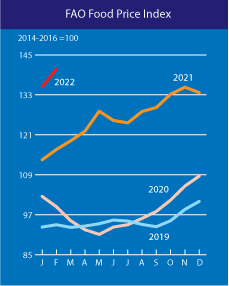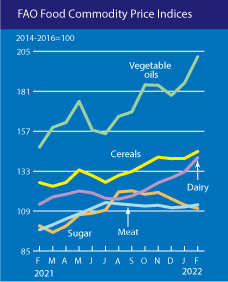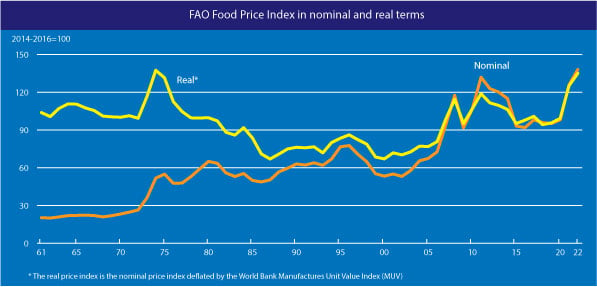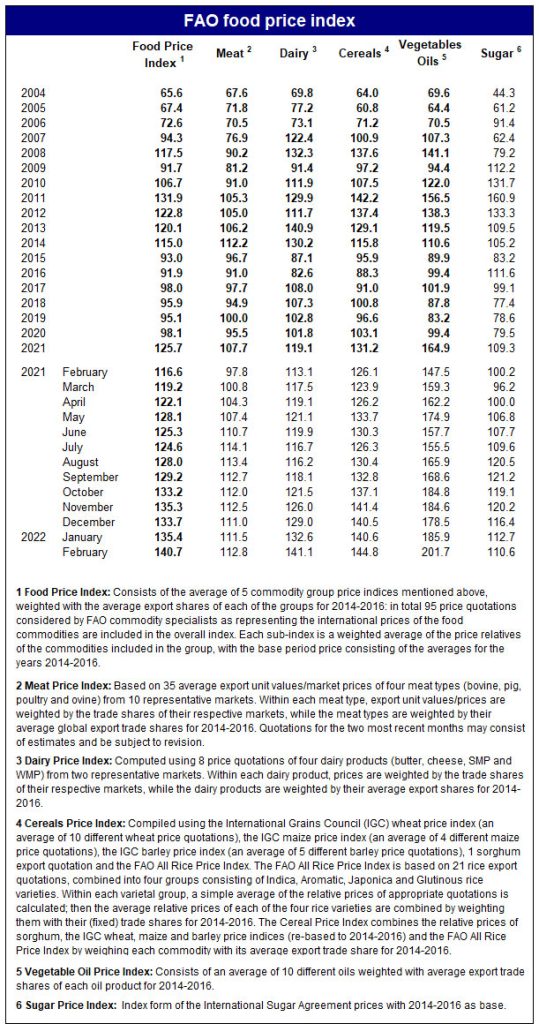The FAO Food Price Index rose to a new all-time high in February 2022… So the Arab Spring was a thing last time there was a price spike. Wait for it. Wait for it. This summer is gonna be a doosy. Any bets on what its going to be with this one?
The FAO Food Price Index (FFPI) averaged 140.7 points in February 2022, up 5.3 points (3.9 percent) from January and as much as 24.1 points (20.7 percent) above its level a year ago.

This represents a new all-time high, exceeding the previous top of February 2011 by 3.1 points. The February rise was led by large increases in vegetable oil and dairy price sub-indices. Cereals and meat prices were also up, while the sugar price sub-index fell for the third consecutive month.
FAO Cereal Price Index
The FAO Cereal Price Index averaged 144.8 points in February, up 4.2 points (3.0 percent) from January and 18.7 points (14.8 percent) from one year ago. In February, prices of all major cereals increased from their respective values last month.
World wheat prices increased by 2.1 percent, largely reflecting new global supply uncertainties amidst disruptions in the Black Sea region that could potentially hinder exports from Ukraine and the Russian Federation, two major wheat exporters.
Coarse grain export prices also rose by 4.7 percent. World maize prices increased by 5.1 percent month-on-month, underpinned by a combination of continued crop condition concerns in Argentina and Brazil, rising wheat prices, and uncertainty regarding maize exports from Ukraine, a major exporter.
Among other coarse grains, both sorghum and barley export prices firmed month-on-month as well, gaining 5.9 and 2.7 percent, respectively.
International rice prices increased by 1.1 percent in February, primarily sustained by the appreciation of currencies of some exporters against the US dollar and strong demand for fragrant rice from Near East Asian buyers.
FAO Vegetable Oil Price Index
The FAO Vegetable Oil Price Index averaged 201.7 points in February, up 15.8 points (8.5 percent) month-on-month and marking a new record high.
The continued price strength mostly stemmed from rising palm, soy, and sunflower oil prices.
In February, international palm oil prices increased for the second consecutive month due to the sustained global import demand that coincided with reduced export availabilities from Indonesia, the world’s leading palm oil exporter.
In the meantime, world soyoil values continued to rise on deteriorating soybean production prospects in South America. International sunflower oil prices also increased markedly, underpinned by concerns over the disruptions in the Black Sea region, which could potentially lower exports. Surging crude oil prices also lent support to the vegetable oil complex.

FAO Dairy Price Index
The FAO Dairy Price Index averaged 141.1 points in February, up 8.5 points (6.4 percent) from January, marking the sixth successive monthly increase and placing the index 28.0 points (24.8 percent) above its value in the corresponding month last year.
In February, international quotations for all dairy products represented in the index firmed, underpinned by the continued tightening of global markets on the back of lower than expected milk supplies in Western Europe and Oceania.
Besides tight global supplies, persistent import demand, especially from North Asia and the Middle East, led to steep increases in whole milk powder and cheese price quotations.
International skim milk powder prices rose significantly as well, reflecting a lower volume of milk deliveries for drying plants in Western Europe, while butter prices received a boost from high demand for spot supplies.
FAO Meat Price Index
The FAO Meat Price Index averaged 112.8 points in February, up 1.2 points (1.1 percent) month-on-month and 15.0 points (15.3 percent) from its level a year ago.
In February, international bovine meat quotations reached a new record high, driven by strong global import demand amidst tight supplies of slaughter-ready cattle in Brazil and high demand for herd rebuilding in Australia.
Pig meat prices also edged up, reflecting increased internal demand and scaled-back hog supplies in the European Union and the United States of America.
Quotations for ovine meat weakened for the fourth consecutive month due to high exportable supplies in Oceania.
Meanwhile, poultry meat prices fell slightly due to reduced imports by China following the end of the Spring Festival and lower domestic demand in Brazil.
FAO Sugar Price Index
The FAO Sugar Price Index averaged 110.6 points in February, down 2.1 points (1.9 percent) from January, marking the third consecutive monthly decline and reaching its lowest level since last July.
Favourable production prospects in major exporting countries, notably India and Thailand, coupled with improved growing conditions in Brazil continued to weigh on world sugar prices.
Ethanol prices in Brazil declined for the third successive month in February on the back of reduced domestic demand, exerting further downward pressure on world sugar prices.
However, the strengthening of the Brazilian Real against the US Dollar, which tends to restrain shipments from Brazil, the world’s largest sugar exporter, prevented more substantial sugar price declines.


What is the FAO Food Price Index (FFPI)?
The FAO Food Price Index (FFPI) is a measure of the monthly change in international prices of a basket of food commodities. It consists of the average of five commodity group price indices weighted by the average export shares of each of the groups over 2014-2016. A feature article published in the June 2020 edition of the Food Outlook presents the revision of the base period for the calculation of the FFPI and the expansion of its price coverage, to be introduced from July 2020. A November 2013 article contains technical background on the previous construction of the FFPI. [FAO]
StrangeSounds.org has been banned from ADS NETWORKS! CLICK HERE TO DONATE AND SUPPORT ME, MY WORK AND MY WEBSITE!
NOW PREPARE FOR THE NEXT NATURAL DISASTER AND EMERGENCY:
PROTECT YOUR HOME AND CAR WITH THE BEST LIGHTNING AND EMP PROTECTION AVAILABLE…
DRINK CLEAN WATER USING THE BEST HOME WATER FILTER AROUND…
You should really subscribe to QFiles. You will get very interesting information about strange events around the world.














Health Ranger has been predicting food riots. I’ve stocked up over the years. I still want more surplus. Like to be able to never have to leave the ranch for years. There’s nothing worth seeing in the welfare bum towns around here anyways. I looked around when I first moved way offgrid, and people are shitheads no matter where you go nowadays. The scammer/Independent contractors out here have two-digit I.Q.’s, and remind me of appliance repair con artist types of the 1970’s. Not even good at being scammers or workers. Inbred retards mostly.
You have a usurper running this country and that’s why this is all happening. Nobody wants to enforce the law on this guy that would quickly take him out and everything will return to normal very quickly.